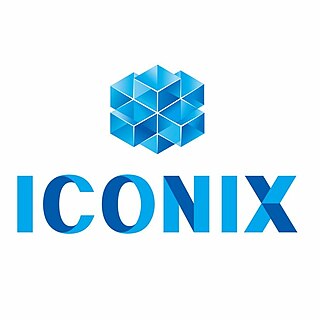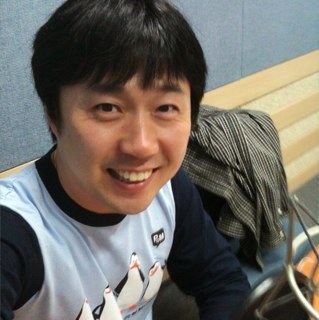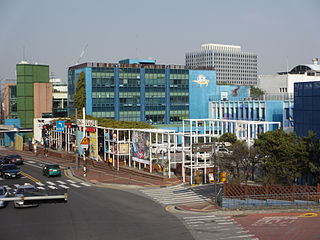
South Korean animation, or aeni is hand-drawn and computer-generated animation originating from South Korea.
Korean April 26 Animation Studio, also known as SEK Studio, is a state-owned North Korean animation studio, based in Ot'an-dong, Central District, Pyongyang.

AKOM Production, Ltd. is a South Korean animation studio in Songpa-gu, Seoul that has provided much work since its conception in 1985 by Nelson Shin. Its biggest claim to fame is the overseas animation of more than 200 episodes of The Simpsons, a total which continues to increase. In 2007, the studio produced a portion of the overseas animation for The Simpsons Movie.

Empress Chung is a 2005 animated feature film, produced in North and South Korea and directed by Nelson Shin.

Iconix Co, Ltd. is an entertainment studio based in Seoul, and is a major South Korean entertainment company formed by the merger of Iconix. The company is commonly referred to as simply "Iconix", the same name used in previous incarnations of Iconix.

Pororo the Little Penguin is a South Korean 3D computer animated television series. The series premiered on EBS 1 in South Korea in 2003. The series has 8 seasons.

The cinema of North Korea began with the division of Korea and has been sustained since then by the ruling Kim dynasty. Kim Il-sung and his successor Kim Jong-il were both cinephiles and sought to produce propaganda films based on the Juche ideology.
Dooly the Little Dinosaur is a South Korean media franchise created by cartoonist Kim Soo-jung. It was originally created as a manhwa (comic) that was serialized from 1983 to 1993. It centers on the titular Dooly, a anthropomorphic baby dinosaur character. The media franchise expanded to include a television series and animated film.
DongWoo Animation Co. Ltd is an animation studio located in Seoul, South Korea. It has produced many animated series and films created and produced in the United States, Canada, South Korea and Japan. The current CEO of the studio is Kim Young-doo.
Hanho Heung-Up Co., Ltd. (한호흥업㈜) is an animation service studio based in Seoul, South Korea. Founded in 1984 by Steven Hahn, over the years the studio has produced animation for many of the industry’s leading SVOD, cable, and broadcast studios and distributors, including Disney, Warner Bros., Fox, Netflix, Nickelodeon, Comedy Central, and others. Hanho has worked on dozens of TV-series and feature films, including: Alvin and the Chipmunks, Star Wars: Droids, The Real Ghostbusters, Teenage Mutant Ninja Turtles, The Spectacular Spider-Man, Bob's Burgers, Doug, The New Adventures of Winnie the Pooh, The Magic School Bus, Turbo FAST, Paradise PD, and many more. In its native land, Hanho is best known for its work on ly, Superboard, which aired on the KBS network from 1990 to 2002.
Brand licensing means renting or leasing of an intangible asset. It is a process of creating and managing contracts between the owner of a brand and a company or individual who wants to use the brand in association with a product, for an agreed period of time, within an agreed territory. Licensing is used by brand owners to extend a trademark or character onto products of a completely different nature.
Tooniverse is a cartoon and anime channel broadcast by CJ ENM E&M Division, in South Korea.

Um Sang-hyun is a South Korean voice actor who began his career by joining Educational Broadcasting System's voice acting division in 1998.

Tayo the Little Bus is a South Korean 3D computer-animated television series. The series is produced by Iconix Entertainment for the Educational Broadcasting System in collaboration with the Metropolitan Government of Seoul. The show was produced with the help of Seoul mayor Oh Se-hoon's administration. It began airing in South Korea on EBS in 2010 and an English-dubbed version of the series began airing on Disney Junior (Asia) in 2012, with Disney Junior following in 2013. In the United States and Canada, Hulu is the exclusive distributor of the series, though the fourth, fifth, and sixth seasons are on Netflix. In Indonesia, the series is distributed by RTV, Indosiar and Mentari TV.

Pororo, The Racing Adventure is a 2013 South Korean-Chinese animated film directed and edited by Young Kyun Park, with a screenplay by In-Kyun Lee and Eun Sook Kim. The film is based on the Korean computer-animated television series Pororo the Little Penguin. In 2014, an English dub of the film directed by Mychal Simka and written by Simka, Harry Glennon, and Ross Mihalko was released featuring the voices of Rob Schneider, Drake Bell, Anthony Anderson, Jon Heder, Jerry Trainor, Dallas Lovato, Jay Mohr, and Simka, as well as original songs by Bell and Smash Mouth.
Events from the year 1985 in South Korea.

The Seoul Animation Center is an animation and cartoon museum and activities center located on the hillside of Namsan in Jung-gu, Seoul. It was established by the Seoul Metropolitan Government in May 1999 to support the South Korean comics and animation industry and later expanded to include games and characters. It is operated and managed by the Seoul Business Agency (SBA) and jointly hosts the Seoul International Cartoon and Animation Festival (SICAF), and other art exhibits and festivals at the center and on nearby Cartoon Street.

Cartoon Street, also known as Zaemiro, or the "street of fun," is a street in the central part of Seoul, South Korea, which extends 450-meters from Myeong-dong Station to the Seoul Animation Center on the hillside of Mount Namsan. The area, created by the Seoul Metropolitan Government, is an open-air cartoon gallery of graffiti-like paintings, comics' quotes and short stories; with small parks and a multipurpose cultural hall.

Animation in North Korea began in 1948 and has been a growing industry since. Before the Korean War, the Pyongyang animation study opened in 1948. In the same year, the north region of the parallel 38th became a communist republic. From 1948 until the 1980s, Pyongyang animation studio produced more than two hundred films.











